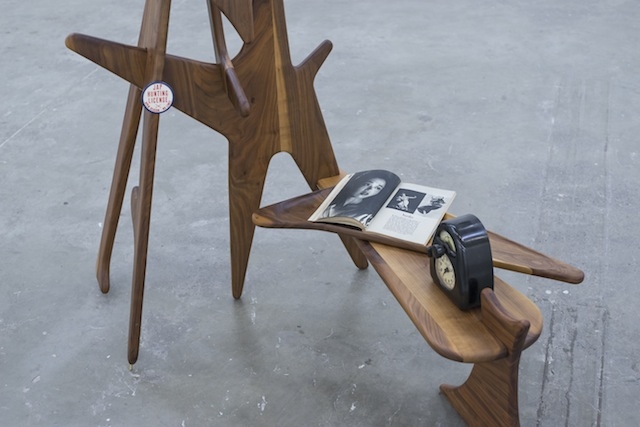Proyectos Monclova, Mexico City through 14 January
‘History is taking flight and passes forever,’ wrote Isamu Noguchi from the Poston War Relocation Center internment camp in Arizona in a letter to Man Ray, expressing his frustrations at the US policy towards Japanese Americans during the Second World War.
In his exhibition titled after the famed designer’s lamentation, Edgar Orlaineta presents new sculptural works and an installation that considers the political and artistic legacies of Japanese-American icons of mid-century art and design who had been interred in concentration camps in the US, a history that was something of a suppressed anathema in contemporary American consciousness and is now being invoked into broad awareness by Donald Trump’s proposals.
Orlaineta’s work often is characterised by midcentury pastiche as he creates obsessive quantities of sculptures that are inspired by or sometimes directly appropriate Eames-era industrial-design objects. In History is taking flight and passes forever he doesn’t entirely avoid these derivative trappings; however his use of explicitly racist vintage pop-culture ephemera as well as archival documents that refer to political and social antagonism towards Japanese Americans contextualises and charges his sculptures’ formal midcentury motifs with an incisive dualism of beauty and pain.
The main gallery is crowded. There are four Ruth Asawa-inspired pieces; five works refer to Larry Shinoda’s automotive designs; and 12 Noguchiesque walnut biomorphic sculptures. With this volume of works it’s easy to miss some of the most biting inclusions in the show. Anachronic Shrine-Desert Memorial (after Isamu Noguchi) (all works 2016) has a copy of the internment order issued to Los Angeles residents tucked into the supports of a desert-scape painted by a Manzanar camp detainee; three sculptures feature ‘Jap hunting licenses’ set reverently on their walnut supports; and another work references the naivety of ushering in the atomic age by placing a curling rendering of a test explosion next to a spinning top with the same shape as the blast’s cloud. The precariousness of the brittle and yellowing paper ephemera that Orlaineta has gently arranged, unfixed, on sleek supports seems to underscore the importance of remembering hateful histories lest their suppression clear the way for repetition.
Seen and Unseen (Road Elements) is an exhibition highpoint. In this installation Orlaineta uses a c-print of a disassembled Shinoda-designed Corvette Sting Ray, Japanese paper lanterns and a Brancusi-like chrome torpedo figure to connect the dots between the streamlined midcentury American automotive design, Modernism, and missile technology. However, it seems odd that in making sculptures that reference Asawa’s work, Orlaineta would opt to use wood instead of, for example, the weaving techniques for which Asawa is most widely known and that she discovered in Mexico.
The tragedy of midcentury design – dating from the 1930s onwards – is that the refinement of its early aesthetics often makes for too beguiling a fantasy. How easy it is to forget that the nostalgia for simpler times that these skinny-legged designs now invoke are the products of an era that was anything but. These are the products of years that ushered in events so horrific that the philosopher Theodor Adorno said they rendered poetry thereafter ‘barbaric’.
Orlaineta’s production for the exhibition was underway long before the US election, but so was the casual and normalised racism that led to the rise of the alt-right that helped elect Trump. In light of the vitriolic campaign rhetoric that seemed to hold a special regard of disdain for Mexico, History is taking flight and passes forever reads as particularly socially urgent. In Mexico City, surrounded by all these lithe sculptures adorned with hateful propaganda, Orlaineta skips over concern that ‘this could be us’ and states, simply, ‘this is us’.
From the January & February 2017 issue of ArtReview
